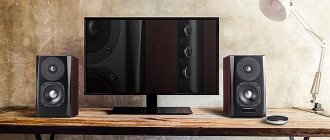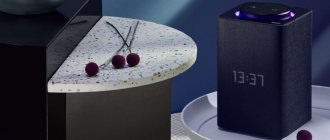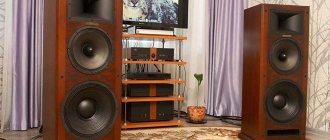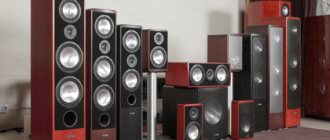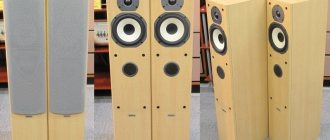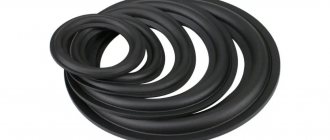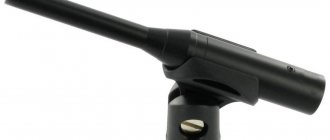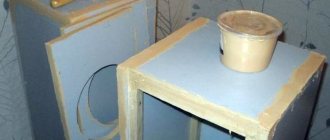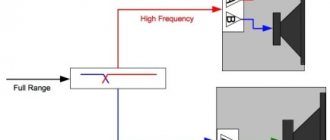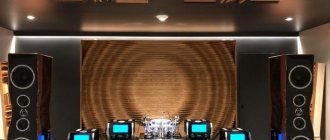Start
Dear friends, allow me to introduce myself. My name is Yuri. He received his name in honor of Yuri Alekseevich Gagarin, like many boys during that period. It was so popular when I was born. Apparently, the energy of that time and the name of the first cosmonaut was, to some extent, passed on to me and became part of the soul, requiring activity. During school years, activity was multidirectional, but did not include studies. In life this did not become a hindrance. Graduated from Technical University with honors. I did not change my profession, chosen on the basis of the maximum complexity of the specialties offered by the university I entered, and I still earn money from it. They trained me to become a designer of hydraulic machines and their automation equipment.
In his free time from work, all sorts of hobbies continued. In another emotional outburst, which happened quite recently, I discovered a wonderful Audiomania store, in particular, its “Do it yourself” section. What I saw there on my first visit was a youthful dream. True, in those days it was impossible to imagine such a thing. The assortment of this store opened the door for me to the world of realizing ideas. I think, like for many other people obsessed with ideas.
In addition to my passion for audio technology, which accompanies me throughout life, I love photography, read science fiction (definitely about space travel - that same energy works out). And one more hobby - I have been making wooden furniture for almost a dozen years. Nowadays we already have serious experience as a cabinetmaker, which allows us to make furniture professionally.
Creating acoustics, which will be discussed, is one of my long-time hobbies. But the accumulated experience, today's opportunities and new desires have allowed us to set ourselves a difficult task - to create acoustics for the home that convey the dynamics, scale and emotionality of concert music performance.
To all readers - my immense affection and best wishes.
Yuri Kobzar
I'm an amateur. I will try to write only about specifics. I will share my practical experience in creating high-level acoustic systems. I address this information to fellow fans who like high-quality sound, who get pleasure not from the background, but from listening to music. People who are in the world of sounds have preferences and favorite records.
In the spring of 2022, something happened to me. In the evening, on the veranda, the chirping of birds reached my ears, a real warmth wafted through, somewhere turned green, the first vegetative aroma arrived, I wanted to sip wine and listen to music. Without analyzing (everything can be attributed to fluctuations of the soul), I felt the need, and I had the idea to acquire good sound for the home. Moreover, there is “music” in the house. But at that moment the term good sound suddenly took on a different meaning. Memories of randomly listening to music in a store (in the high-end room), a great opportunity to experience the highest quality sound from several friends, came into my head. All this happened years ago, but the need for good sound took shape in the spring of '17. Despite the fact that a reverent attitude towards “good” music has accompanied me all my life, and I almost always had the opportunity to listen to sound of decent quality, it suddenly became clear: the music sounding from acoustics should not just be clean, detailed, powerful, deep, natural, bewitching or even amazing (body at high volume is a joke). The sound reproduced by acoustics must convey the emotions of the soloists and musicians, and all those who prepare the recording for us, the listeners.
According to preliminary estimates, possibly overestimated, it turned out to be unaffordable to buy such equipment. I didn’t want to waste money on something good that was available. Thus, the task arose to build the highest class acoustics available at home. Without laboratories, high-precision measurements, but so that the breed, solidity and eliteness of the sound is undeniable. To create just such an impression from listening.
As a small digression, it should be said that the idea had a basis. I had certain skills at my disposal: in my youth I built acoustics in a “closed box”. I was happy with the sound of it. Various transistor amplifiers were soldered together, one model is extremely high quality. Now, in addition to the previous half-forgotten knowledge, skills and experience, I have added a love for making furniture from wood and a certain set of carpentry tools. Additionally, I wanted to acquire a high-quality tube amplifier. In order to shorten the implementation of the plan, I offered participation to my enthusiastic friend and do-it-yourselfer, who has the base of the radio department of UPI (Ural State Technical University). It was agreed that acoustics (selections, calculations and implementation) would be my task, and the lampmaker would be part of it.
From this position they began to “shake the old days.”
Source
The source is the location of the original signal, so it is very important to choose a neutral source that will not introduce anything of its own into the signal. Fortunately, today most equipment is made quite well. Even entry-level digital players perform with a much higher degree of accuracy when compared to acoustic players at the same price. Good DACs can be found for around US$1200 and will be decent audiophile gear.
Advertising for The Fisher Audio Systems, ~1960
However, if you've heard an expensive, high-end turntable in a well-built system, you'll likely agree that vinyl is superior in sound to other formats. The record, in our opinion, is better than the CD and has only one drawback - background noise. By the way, even a relatively inexpensive turntable can outperform an expensive CD player in terms of sound quality.
Whether or not to buy an analog source is up to you. But we would advise going to a store where you can listen to different examples. Modern turntables with new cartridges sound better than those sold 20 years ago. And this is amazing.
Choice
The issue of building an AS began with the study of theory and related materials. I, like many builders of their own acoustic systems, faced the question of choosing an acoustic design. Knowledge, information, opinions began to accumulate and be systematized, but the answer to the question about the type of acoustic design of the speakers remained open. At this time, three 75GDSh3-1 broadband heads became available to my partner. The local cultural center decided to throw away two stage subwoofers that had worked for more than 30 years. Each had two speakers. In one of them, the speaker failed, hence the decision to throw it away. Listening to the speakers "on the floor" confirmed the expectation of "no sound". Listening in the original subwoofer box did not change the ratings. Almost without enthusiasm, I began to dig through the Internet on the topic of using speakers of the existing type in speakers. Materials from comrades who had already built speakers based on these speakers were quickly found. I liked the option with “tekuvete” (tqwt) Voight pipe - I am attaching the material, the authorship has not been established, see link). I liked this option, among other things, because of the “open body”, for which some people already liked it. Why: No or minimal speaker damping as needed. In other words, there are no obstacles created for the dynamic head during operation, and this, as I understand it, means a minimum of conditions for creating external resistance and, as a result, distortion. Also, the resonant frequency of the speaker in the housing with the pipe does not change. This, in turn, should ensure the reproduction of a richer bass component, which is the basis of the rhythm, providing volumetric sound and enhancing the psycho-emotional perception of the musical program. With internal resistance (after listening to the speakers), with the fear of getting a weak result and, nevertheless, with hope, I bought three sheets of 12mm construction plywood to replicate the proposed design in the material. The modification consisted of using radial transitions in each corner (for the first time I bent plywood), installing a stiffening rib inside (taking into account the dimensions and thickness of the material) and installing a rigid removable rear wall for the convenience of subsequent possible damping.
I don’t give the manufacturing technology. Open it too. Considering my experience in working with wood, I believe that each craftsman who undertakes the manufacture of such a structure will have his own specific design and manufacturing work. The specifics are related to the conditions, skills and set of tools. I got used to working with glue, refusing metal fasteners (except for the removable back wall). This ensures the absence of technological racks that take away volume, giving additional geometry in the sound channel, which from my point of view - a certified hydraulics specialist - is not good for the movement of a sound wave along the channel. And the task, by the way, is to create conditions for its smooth, laminar (there is a term meaning the absence of turbulence) movement along the channel. This reduces the likelihood of overtones that are unnecessary for high-quality sound.
The sound of the built speaker surprised me right away. Powerful, bright, beautiful and different from my signature three-way bass reflex (FI) speakers of the English brand. Significantly excellent. With emphasis on the word “excellent”. The surprise was intensified by the fact that there was England, the intelligence of engineers and large-scale production, and here was a 35-year-old miracle in a plywood box. After the first surge of emotions subsided, it became clear that one speaker was not enough for this speaker. There are not enough tops and... bottoms. The bass is low, beautiful, with many shades (which is not heard on the FI) and, at the same time, weak. You can talk yourself into such a sound, but the drawback is noticeable.
Having doubts about the ability of this speaker to play bass in a wideband speaker system, I built a tapering labyrinth - a transmission wave line (TVL). According to reviews online, this is exactly what is needed. I describe without details or arguments in favor of such a decision. I do not provide recommendations and dependencies for constructing TVL. Everything is on the Internet. I made this design more technologically advanced: with legs, without roundings. It should be noted that the speaker turned out to be more compact in size. Here's her cut.
Many authors on the network mention the importance of correctly made calculations of the transmission-wave channel, the absence of fundamental errors, the complexity of the design and the need to accurately repeat it during manufacturing. At the same time, apart from geometry and rules for choosing speakers, there is actually nothing in their approach. When drawing the design of speakers with TVL, I was accompanied by a feeling of deep understanding of mechanics, but not acoustics. I did everything on faith. After all, many people have already shared practical experience, achieved results and photographs. Many were satisfied with the resulting sound. This is a weighty argument.
I took construction plywood again. This time, two sheets, taking into account the remains from the previous version. Made it quickly and accurately. It should be emphasized that the bodies of such structures are excessively rigid, even when using 12mm plywood.
So, the listening experience is very good. The disadvantages are the same. If the lack of highs is a speaker design, then the lack of bass is a matter of the cabinet. It should be said that the bass has become more expressive and emphasized. This was noted independently by all audition participants. The surprise was as follows. At first, we listened to each speaker separately. I wanted to hear its capabilities and compare it with another option. Moreover, the first experiment of repeating the design yielded only one column. Then they were connected together. The effect was amazing. Not only a panorama of sound, a stage emerged. First of all, the sound itself has changed. Its power, openness, and lightness stunned me! Yes, later, while listening to an unequal pair of speakers, I had to raise the HF and LF on the amplifier. But the sound was not just beautiful. He held, pulled to himself. My favorite tracks sounded as if I was listening to them for the first time. On many, shades of bass and mid frequencies began to be heard, the existence of which I had not even suspected before with English floorstanding speakers. The wife's friend, who was present with her in the house in the next room while testing a pair of speakers at various volumes and styles: chamber music, jazz, electronics, left and said that she had been to the Philharmonic or a concert. This phrase was not delicacy towards the owners, but similar to the truth. The propagation of sound across adjacent rooms was a pleasant surprise. This will be an important point when receiving guests to create light, unobtrusive musical accompaniment in several areas at once. He started turning on the equipment every time he passed by. And, in the end, after three days, he finally gave up and asked the future owner to take this test version of the acoustics home to listen to until the time came for the production of ceremonial-looking speakers.
The conclusion was this: if I had chosen the speakers in the store, the sound of the resulting speakers (not the plywood look, of course) would have suited me completely. The resulting sound is said modestly. The sound is great. When a pair of speakers are playing, the high frequencies are almost enough. This is not sand, the speaker cannot reproduce it. But what it reproduces already satisfied our requirements. The resulting sound was shocking, turning something inside me, causing lumps in my throat. No exaggeration. There was only one “thorn” left - the bass on the amplifier was turned up to maximum. However, the owner of the speaker also liked the sound. Later, it was even decided to make the final version based on TVL: the dimensions and sound of the bass prevailed.
Top 10 rating according to KP
Editor's Choice
Focal Chora 826 (average cost 80 thousand rubles)
Focal Chora 826. Photo: focal.com
This floor-standing speaker from the famous French manufacturer received an award for the best price-quality ratio. The “Chora” series has replaced the legendary budget “Chorus” line and can pamper the listener with audiophile features characteristic of much higher series. The only disadvantages can be written down as a certain “Ikeaness” in the design, but this is a matter of taste.
Specifications:
| Location | floor |
| Type | passive |
| Acoustic design | bass reflex |
| Number of lanes | 3 |
| Power | 250 W |
| frequency range | 48Hz-28,000Hz |
Advantages and disadvantages
Brand, price-quality ratio
Design
show more
SVS Prime Pinnacle (average cost 210 - 240 thousand rubles)
SVS Prime Pinnacle. Photo: market.yandex.ru
This model from this American manufacturer is the best speaker system of last year according to EISA. Very expensive, very cool made! A special feature of this system are three low-frequency drivers, where each has its own separate bass reflex at the rear.
Specifications:
| Location | floor |
| Type | passive |
| Acoustic design | bass reflex |
| Number of lanes | 3 |
| Power | 300 W |
| frequency range | 29Hz-25,000Hz |
Advantages and disadvantages
Perfect in everything
The price bites
show more
Monitor Audio Bronze 100 (6G) (average cost 40 thousand rubles)
Monitor Audio Bronze 100. Photo: monitoraudio.com
The best bookshelf speakers of 2022. It boasts a wide frequency range, indiscriminate musical genres and excellent power reserves. A special feature of this model is a specially designed bass reflex port, thanks to which the system is very unpretentious in its location.
Specifications:
| Location | shelf |
| Type | passive |
| Acoustic design | bass reflex |
| Number of lanes | 2 |
| Power | 100 W |
| frequency range | 37Hz-30,000Hz |
Advantages and disadvantages
Price-quality ratio"
For this price - no
show more
What other Hi-Fi speakers are worth paying attention to?
ELAC Debut B5.2 (average cost 22-30 thousand rubles)
ELAC Debut B5.2. Photo: elac.ru
An excellent entry-level bookshelf speaker system. Thanks to the bass reflex located at the front, they can even be placed close to the wall. Perhaps their sound may seem a little harsh, but the detail and dynamics are at their best.
Specifications:
| Location | shelf |
| Type | passive |
| Acoustic design | bass reflex |
| Number of lanes | 2 |
| Power | 120 W |
| frequency range | 46Hz-35,000Hz |
Advantages and disadvantages
Excellent price-quality ratio
Design for everyone
show more
Fyne Audio F302 (average cost 55-60 thousand rubles)
Fyne Audio F302. Photo: fyneaudio.com
Although this company is a new player on the market (since 2022), it was founded by people from the Tannoy company. In fact, for a fairly affordable price we get a very mature floor-standing system with excellent lows and a wide frequency range. This speaker has quite bright highs, which requires some attention in choosing an amplifier in order to avoid frequency distortion.
Specifications:
- Location: floor
- Type: passive
- Acoustic design: bass reflex
- Number of stripes: 2
- Power: 120W
- Frequency range: 36Hz-28,000Hz
Advantages and disadvantages
Great big sound, great bass
It is necessary to carefully select an amplifier for them
show more
Ruark Audio MR1 Mk2 (average cost 35 thousand rubles)
Ruark Audio MR1 Mk2. Photo: market.yandex.ru
The compact desktop wireless acoustics Ruark MR1 will be an excellent solution for those who do not want to hassle with equipment, who do not need to cover large rooms, but still want a cool adult sound. The speakers are equipped with Bluetooth, optical input, subwoofer output and remote control. At the same time, you can connect a battery pack, which makes them portable, and it is also possible to use one of the speakers as a mono system.
Specifications:
- Location: shelf
- Type: active
- Acoustic design: bass reflex
- Number of stripes: 2
- Power: 2×20 W
- Frequency range: not specified
Advantages and disadvantages
Fantastic functionality, great sound
No USB
show more
DALI SPEKTOR 6 (average cost 40 thousand rubles)
DALI SPEKTOR 6. Photo: dali-speakers.com
The only floor-standing model in the Spektor budget line. The system is two-way, has two identical mid-frequency drivers and two bass reflexes. It looks very impressive, has a very assertive sound, not inclined to hide the imperfections of the sound path or audio recording. You should be very careful when choosing an amplifier for this acoustic system in order to fully reveal all its strengths.
Specifications:
- Location: floor
- Type: passive
- Acoustic design: bass reflex
- Number of stripes: 2
- Power: 150 W
- Frequency range: 43Hz-26,000Hz
Advantages and disadvantages
Value for money, expressive sound
Demanding on the quality of the path
show more
YAMAHA NS-777 (average cost 50 thousand rubles)
YAMAHA NS-777. Photo: ru.yamaha.com
A legendary model, a veteran on the market, one of the most popular speakers in its class. The three-way system with two woofers produces a luxurious, fat bottom end. Balanced sound, excellent detail and dynamics - all with it. This is a universal option in the case of “when you don’t know what to buy, buy this.”
Specifications:
- Location: floor
- Type: passive
- Acoustic design: bass reflex
- Number of stripes: 3
- Power: 100W
- Frequency range: 30Hz-35,000Hz
Advantages and disadvantages
Balanced sound, excellent bass
Varnish scratches easily
show more
KEF Q350 (average cost 30-35 thousand rubles)
KEF Q350. Photo: kefrussia.ru
Beautiful, unusual bookshelf speakers sound just like they look: precise, tough, detailed. They are not inclined to embellish the sound, almost like studio monitors, presenting it as it is, unceremoniously showing all the flaws in the recording and the imperfections of the musical path.
Specifications:
- Location: shelf
- Type: passive
- Acoustic design: bass reflex
- Number of stripes: 2
- Power: 120W
- Frequency range: 63Hz-28,000Hz
Advantages and disadvantages
Detailed and honest sound, low price
You should carefully consider the choice of amplifier
show more
ProAc Response D Two (average cost 300 thousand rubles)
ProAc Response D Two. Photo: market.yandex.ru
In principle, these bookshelf acoustics can already be classified as Hi-End. This company has long established itself as a manufacturer of impeccably cool speaker systems. Incredibly detailed and natural sound, a very wide frequency range that is not typical for bookshelf speakers.
Specifications
- Location: shelf
- Type: passive
- Acoustic design: bass reflex
- Number of stripes: 2
- Power: 150 W
- Frequency range: 30Hz-30,000Hz
Advantages and disadvantages
Perfect in everything
Very expensive
show more
ordeals
Meanwhile, the issue of creating speakers for “own use” has become urgent. There is a high probability that after the speakers on the 75GDSh3-1 speakers, the search for good sound would have come to an end. It happened quite quickly, and it almost hit the mark. Fortunately or unfortunately, there was no second pair of 75GDSh3-1 or 3-3 heads. While crawling on the World Wide Web, collecting and analyzing information, continuing my studies, I began to closely examine the acoustics of the English company Tannoy. An ideal speaker is a device capable of linearly reproducing the entire spectrum of sound from one point. And life consists of compromises. Creating acoustics is a search for the optimum among many compromises. Each version of the speaker solves its own problems and becomes a tool in the hands of marketing: a successful combination of speakers in the speaker system, beautiful (correct) frequency separation, protruding bass, a clicking tweeter, a unique design, the use of valuable wood in the case, or simply a well-known brand. All together or separately is designed to convince the buyer of the correct choice. The older Tannoy acoustics (Westminster and Canterbury) interested me in appearance, and they are built on just one speaker. Sound from one point! The ancient, well-known company, which maintains its leading position to this day, has its admirers. I soon learned that the Tannoy acoustics are still two-way, but the LF/MF and HF speakers are coaxial. From an engineering perspective, this solution turned out to be very attractive. Great solution. On the same network I read the praise of some and the disappointment of others of the owners of this acoustics after moving it from the salon to their home. I remembered that I myself appreciated the sound of Tannoy several years ago in the listening room of a store. Then I liked the Cornwall version of the American Klipsch more. And another understanding came - good acoustics do not always sound good (on different musical material and in different rooms), and this fact had to be somehow taken into account when designing your own speakers. For example, Tannoy is equipped with two controls for adjusting the midrange and treble.
Given the need to accept compromises, the intention was to create something similar to Tannoy Westminster or Canterbury. It turned out that you can order complete copies of Canterbury speakers at “affordable” prices in China. They even offer their own speakers. There were no reviews about the quality of the system and sound. I decided not to risk it. After analyzing the accumulated information, I began to search for the design of Tannoy acoustics. I found something for Westminster speakers, and in one Polish chat - 150 photos of the process of making a copy of this acoustics. The decision to repeat almost happened. Stopped planning the installation site. Still, Westminster is designed for a large space. Of course, it is possible to install them in a room in an ordinary apartment, but the discrepancy between the dimensions of the living space and the two huge speakers is striking. I have a private house and some free space is available for accommodation. However, this option (with difficulty) was rejected from implementation. Because of the size and the unavailability of native Tannoev speakers (as well as their high cost). In addition, the design will be largely guesswork (precise drawings are not available). In this case, you cannot expect high sound quality. I wanted to have a controlled process. The study of the issue continued, but the coaxial Tannoy speaker did not give rest. Frankly, I continued to look for reasonable opportunities to purchase Tannoy heads until I came across the Spanish Beyma. This manufacturer offers a coaxial two-way speaker design that interested me. Here is a photo of a coaxially installed tweeter in the center of the woofer.
The characteristics of the reproduced frequency band were not as “chic” as those of the Tannoy. But, I remember, when in my youth my friends and I connected different heads to an audio frequency generator, we were surprised at the limited range of audible frequencies. The effect at low frequencies was especially interesting: significant movements of the speaker cone are visually observed, and at the same time there is practically no sound. Therefore, having had some doubts, I chose the 15XA38Nd speaker from the Spanish Beyma with a neodymium magnet. Of course, I was confused by the lack of traces on the Internet of using this speaker for home acoustics: both on Russian and Western resources. The power rating of the speaker was confusing: 350 W for low frequencies and plus 90 W for high frequencies. The head size was 15 inches. The lines I read from someone online remained in my head: “...transmission of the grandiose character of concert-scale sound is achieved with heads 12 inches and higher.” I agreed with this statement in my heart. And the parameters of Westminster and Canterbury confirmed the correctness of this phrase. It was also clear that the dimensions of the acoustics with these heads would be significant. But the characteristics of the speakers, their declared sensitivity of -99 dB, pushed aside the last doubts. The decision to take the risk was made. For those interested, you can find the characteristics of the head online or on the Audiomania website.
I ordered the speakers and had to wait almost three months for delivery. At this time, the issue of acoustic design returned again. Without digression, I will say that the material “Rogozhin’s Labyrinth” seriously helped me confirm my choice. It can be easily found on the Internet. I do not provide a link, since the author asks for prior approval (although the material is available for free). But there, thanks to Rogozhin, both justifications and practical recommendations are given. I would venture to make a statement: this is the only material without water, to the point, with a full set of recommendations for practical results. Hence its popularity.
After this stage, the ordeal of making a decision was left behind. Ahead were the pleasant hardships of night acoustic calculations and speaker cabinet design.
↑ Conclusions
It shouldn't have been done this way.
Fuck these GPIOs, everything had to be done on USB. The keys and volume control are a USB keyboard—homemade, of course. USB DAC is not a problem, USB display, why not! This would allow you to take a mini-PC without HDMI, they are cheaper. And in general, all this could be done on any motherboard, and only then choose a modern mini-PC. You need to master USB! The DAC power supply had to be placed on the same board as the DAC. For better cooling, the bottom of the case should be made perforated, and the boards should be placed vertically. The player successfully survived the hot summer. I measured it and the transformer was heated to a temperature of 50 degrees. It’s normal, but you still need to do something like this:
Rice. 12.
Example of good cooling
Rice. 13.
In the interior
A little "around the bush"
Everything stated above briefly represents the path traveled. I described it for those who are interested in creating a high-quality speaker system with their own hands and who are faced with similar questions. The process of developing the speaker from scratch is described here, and the path was completed completely until the creation of a prototype. Anyone who wishes can also walk the entire path, more consciously. It will be possible for someone to cut corners on it.
A few words about Rogozhin's labyrinth. The attractiveness of this design lies not only in the opportunity to obtain excellent acoustic sound results (I say this with understanding), but it also opens up the possibility of designing the appearance and internal architecture in the widest range. Ultimately, this technology allows you to create speakers “for yourself.” Some kind of custom tailoring. It is extremely convenient and attractive. Probably everyone understands the difference between a purchased ready-made cabinet and a built-in one or one formed according to specific requirements. The functionality and adaptability of the second option are higher. If you take into account the possibility of creating an appearance according to your requirements, connecting the appearance of the speakers, color with the interior in the placement area, the value of the option further increases.
I will not hide that the understanding of the goal during acoustic calculations according to Rogozhin’s recommendations should be clear. At the first stage, this is achieved by following the instructions given in the material and, already at the second stage, ... gained experience. In order to achieve the desired result, I had to perform many acoustic calculations to obtain the optimum and build six experimental options in order to reach the seventh - the final one. By comparing the results obtained in material and sound, you can clarify the calculations performed and make the right choice of option, adjusting it to your preferences, ensuring excellent speaker sound.
Equipment racks
Proper installation will help turn a good audio system into an excellent one, and speaker stands play a special role here. For some speakers, the load from their own mass is not a hindrance, but for other models, more resonance is required to achieve the correct tonal balance. Therefore, it is important to choose the right stands for your speakers.
Cabiart catalogue, 1957
It is also advisable to use racks for both analog and digital components. Quite often, the cause of unpleasant artifacts in sound is unwanted vibrations in the player and stand. Analogue sources especially need good protection from external vibrations. Finally, all equipment must be accurately leveled (without tilting).
For those who are not tired
Quite a practical side. So, the choice of dynamic heads is behind us, and the choice of design (labyrinth channel) is also behind us. On Rogozhin’s recommendation, I installed the Hornresp program from an Australian developer. After following the step-by-step instructions, I got the first result. I will say this, almost blindly I had to perform at least a hundred calculations to meet all the requirements. What you need to strive for - the instructions were given by Rogozhin. Next I share my own experience.
First of all, a photo of the attempts made to find the desired sound:
Here are five housing options for one type of speaker. All options, except the last one (this is the sixth option, obtained by altering the fifth), are made in the size of 1520 mm in height (the height of the plywood sheet). The width and depth of the housings are different and depend on the design cross-section of the channel. The internal architecture is also different. The first option (the right body in the first photo) is made of 15 mm plywood. The weight of the body is about 70 kg (without finishing). All subsequent ones are 12 mm plywood and weigh from 35 to 55 kg. Light vibrations of minor surface areas on 12 mm thick speaker cabinets are present at a power supply of 100 W. To be honest, the developed sound pressure at such power in a limited space cannot be sustained for long. It's good that there are no neighbors behind the wall.
Thus, at a comfortable volume level, cabinet vibrations and overtones are not noted. By the way, no overtones were noted at any volume level.
- The features identified during the process of gaining experience are as follows:
- At first, the explanation in paragraph 9 of Rogozhin’s instructions about the parameters Con (1) and Con (2) was not clear. Only later did I realize that these were the lengths of two sections of the resonant channel. Together they make up the total channel length, which affects the tuning frequency. And they are expressed in centimeters.
- On large speakers, providing the option of collapsing the channel suggested in the instructions will lead to an increase in the height of the speakers. I had to invent. The final fundamental version adopted for the work is as follows:
Of course, during the construction of six options, the manufacturing technology, design details of the speaker, and methods for folding a large channel were developed. In real life, the insides of the speakers look like this:
And so on.
- I noticed some incorrect operation of the program. For example, during the calculation it is possible to ensure group time delays (GTD) within the recommended norm. When printing the calculation result, the group delay diagram has serious distortions, unacceptable emissions that do not correspond to reality.
Those. The calculated group delay emissions do not exceed 20ms (screen copy on the left), and when printing they drop to a value of 670ms (right image). Attention, the speakers manufactured according to the above calculations ensured smooth operation, without overtones or unevenness. You have to believe the left image.
- The accumulated experience allows us to offer the following recommendations when performing calculations:
- The tuning frequency of the speaker channel is better if it is close to the resonant frequency of the head. You can go higher, but who needs it?
- Pay attention to ensuring that the channel's frequency response tuning section is horizontal from resonance and above. I confirm that a slight increase in the frequency response in the resonance zone (in the given figure corresponds to a frequency of 38.36 Hz) is clearly felt “by ear” during operation of the speakers.
- When setting the 1pi-speaker placement zone at the wall (Ang parameter), the output for the musical speaker should not exceed 102-104 dB (higher, it fills your head even at low volume and you have to turn the bass below zero). It gives the impression of crumpled bass, there is really a lot of it. Please note that the optimized speaker output is based on a sensitive speaker (-99 dB). I suspect that if using a speaker with lower sensitivity, the speaker output will need to be reduced accordingly.
- When calculating, it is possible to ensure that the channel is tuned to a frequency below the speaker resonance. It is possible to ensure the total output of the speakers is noticeably higher than the speaker itself. In the first case (the tuning frequency is lower than resonance), we get blurred bass and reduced articulation. The lower the setting from resonance, the more noticeable the effect. In the second case (I tested the version with an speaker pressure of about 107.5 dB), the bass seems to be clogged, powerful, and unintelligible. It's hard to listen. You quickly get tired of this sound.
- It was noticed that the volume of the third mode quenching chamber (CMQC is my term), which is located in the S1-S2 channel area, directly affects the quality of quenching of this mode. We reduce the volume of the CGTM while maintaining the length of the channel section, the range of the mode increases (in the figure above, its surge corresponds to a frequency slightly above 100 Hz) and, on the contrary, with increasing volume of the CGTM, the surge of the mode decreases. The change in the volume of the CGTM was carried out by changing the cross-sectional area S1.
Interconnect cables
Interconnect cables carry the lowest level signals in an audio system and vary greatly depending on their structure. Generally, a cable's sound is independent of its price, so beware of "precious" cables.
Interconnect cables will not deteriorate due to the fact that they are listened to once again as part of the system - ask the seller to give a couple of recommendations, and rent the cables home. The cable can affect the timbre in a way that eliminates minor flaws in the audio system. However, it can also, on the contrary, reveal all its shortcomings. Some audiophiles spend thousands of dollars on cables, but we're confident there will be cables in the $100-$500 range that will be perfect for your system.
Advertisement for a home system consisting of a Regency HF-150 amplifier, a Webcor Diskchanger and a Jensen Duette speaker, 1956
Never think of interconnect cables as a solution to audio problems - rather, look for the component that is ruining the sound. It should be replaced first of all.
Crossover debugging
The approaches and features of creating acoustic design for speakers were described above. It should be noted that the dimensions and weight of the speakers are impressive, the power of the speaker used is high. When acoustic systems were conceived, there was a belief that they should be listened to with an input power of 0.5 Watt. This circumstance was one of the limitations when choosing a speaker. There was doubt that a powerful speaker would provide effective operation with low power input. Despite the available power reserve, the built speaker prototypes perform this function, providing excellent sound with minimal power input. Moreover, without detracting from the grandeur of the sound.
Currently, the resulting speakers are connected to a Sony amplifier, whose volume level is calibrated in decibels. Late in the evening, when there are no extraneous sounds, the acoustics sound great and bright at a volume of minus 66 dB. I would also like to note that the speaker power reserve guarantees operation of the speakers with minimal linear distortion at any volume at a comfortable level.
So, debugging the sound in the crossover.
I was initially disappointed with the set of speakers I received and the FD-2XA crossovers I ordered from the manufacturer (Beyma, Spain) for these specific speakers. The first turn on at low volume led to complete bewilderment. The sound was simply terrible. At low volumes there was almost no bass. As the volume increased, they turned into something completely absurd, emitting incredible muttering. There was no music as such.
After a 3-4 hour run at high volume (70-90 W), the speakers started working (warmed up). However, dissatisfaction with the sound did not disappear. No soulfulness, no grandeur of bass, no desired emotions. Only commendable sound detail.
As I mentioned earlier, sound development was carried out in two directions: searching for optimal labyrinth parameters and working with crossover. The labyrinth work is given above. The crossover also taught its lessons. His diagram was found on the Internet. It consisted of first-order filters with a matching circuit for the input complex impedance of a low-frequency loudspeaker. The crossover frequency, according to the Beyma website, is 1800 Hz.
Of course, I could describe in detail all the searches and adjustments of the resulting filters, but something tells me that such a presentation would be boring and uninformative. I will state it in the abstract.
- It turned out that after turning off the 15 microfarad capacitor, bass reproduction became more pleasant.
- Tests have shown that the acoustics produce audible distortion on some musical compositions. It was possible to establish that the distortion is caused by the high-frequency part of the speaker. Distortion disappears when the cutoff frequency of the high-pass filter is shifted to 2500 Hz and higher.
- To reduce the brightness, one might even say, the “loudness” of the speakers in the midrange, instead of a 2.2 µF capacitance, it is better to use a 0.68 µF capacitance.
After such changes, the sound became very good, but still not entirely satisfactory. An attempt to leave the woofer without inductance L1 did not further improve the sound of the speakers. However, the uneven frequency response of the speaker needs to be compensated. The manufacturer's inductance was kept in its place. Its influence is well felt.
And so, after a long period of listening to various genres, after trying to vary the values of the remaining filter elements right while listening, “on the fly,” so to speak, I turned off the RC matching circuit (8.2 Ohm and 8.25 uF - indicated in the diagram). The effect was amazing. The feeling of a loudspeaker sighing, having found freedom, previously held by some kind of noose. The previously held sound broke out, flew, became light and noble. It is impossible to convey in words the newfound lightness and virtuosity of the updated sound. Exactly that sound has appeared, from which an internal response arises, chills go through the body, and pouring music fills all the cells of the brain.
It should also be noted that the Beyma crossover inductors are not serious. They are wound with 1mm copper wire. For the woofer, the inductance parameters are 1 Ohm and 1.44 mH. At high powers, loss of bass energy is guaranteed. Taking into account the inductance parameters of the low-pass filter obtained by measurement, I ordered inductances for the low-pass and capacitances for the high-frequency sections of a higher class.
↑ Block diagram of the player
Rice. 2.
Block diagram of an audio player.
In green on the block diagram I marked the parts that were discussed earlier.
Those not considered include a video adapter with displays and connecting the Raspberry Pi to devices. Unfortunately, the raspberry does not have SATA ports, so the hard drive is connected via a USB -> SATA adapter. The speed of downloading files to the audio player over the network averaged 8 MB/s. It's like writing to a flash drive. Sometimes it’s enough to upload a new album, but the mere presence of an adapter doesn’t make the device any better, of course.
The player's keyboard is ordinary buttons connected to the raspberry's GPIO. The SPI interface of the volume control is software, the video adapter is hardware.
Total:
The work performed made it possible to adapt the parameters of the resonant channel to the selected speaker and ensured that the speakers sounded no lower than the expectations drawn by consciousness. I'll write about the sound below. All work took about five months (weekends and evenings, taking into account the presence of a fuse, time for listening and analysis, for the following calculations, etc.) and required certain costs. I can confidently say that the sound level corresponds to acoustics in the price range of two million rubles. Actual costs, especially taking into account existing equipment, are disproportionately lower. The path traveled was not easy. The created speaker sounded not only thanks to the accurate or successful calculation of the resonant channel, intuitively, to some extent, the chosen speaker, its approach to modeling and manufacturing the body. Let me remind you that the built acoustic system is a two-way system, the presence of a crossover is mandatory. Working with the crossover also allowed me to contribute to the final sound and gain useful experience. Damping was not used in the speaker design. Perhaps I will make an attempt to evaluate the effect of damping in a particular case. I can say that the accumulated experience made it possible to evaluate the two versions of the manufactured speakers for the 75GDSh3-1 speakers mentioned at the beginning, to see the shortcomings of the bass tuning and to make adjustments.
Currently there is no ready-made front speaker option for the 15XA38Nd speaker. There is a project. A new calculation has been made for speakers with a 75GDSh3-1 speaker with increased bass output. The new variant will be equipped with a BC25SC06-04 tweeter. Taking into account the existing workload and delivery of additionally ordered components, these projects will be implemented no earlier than October-November of this year. The results will be presented. Part of the speaker cabinet design for the 15XA38Nd head is shown below:
↑ Player diagram
Rice. 7.
Electrical circuit of the player.
All boards are mounted on a 3 mm aluminum base (see Fig. 8).
The body of the plastic VCR player was uneven, with all sorts of protrusions and fittings; the aluminum foundation made it possible to install the boards in any way and provide convenient grounding for some components. Regarding grounding: the analog circuit boards are connected to ground only in the volume control and DAC, in fact through the digital ground of the i2s bus and the SPI bus at the volume control, which are then connected to the raspberry connector and connected to ground through the Raspbery PI mounting holes. The power transformer iron for the power amplifier is also grounded. In the power amplifier, only the radiators are structurally grounded (screwed to the foundation), which, due to the dielectric, do not come into contact with the amplifier microcircuits. The common wire of the speakers is connected directly to the power supply, and not to the power amplifier board.
The five-volt power supply is grounded on both sides through the mounting holes; it is important to connect the Y-capacitors of the switching power supply to ground. The hard drive is powered not via a USB cable, but by separate wires.
Raspbery has very delicate GPIOs, so resistors R1-R6 on the keyboard eliminate the possibility of the pin being shorted to ground, in case of a theoretically possible incorrect configuration, instead of input to output. I tried to put a resistor on each GPIO, just in case. Almost all the wires go under the foundation - isn’t it beautiful?
Rice. 8.
Under the hood.
Follow the general rules
Network players, when first introduced, are somewhat puzzling with the necessary connections and settings, as well as the control method using an application for a smartphone, or even better, a tablet, but then they amaze with the possibilities for choosing music to listen to. But still, these are full-fledged Hi-Fi components, the connection of which requires good cables, but more importantly, the presence of a local computer network with high-speed Internet access. Most often, they support wireless Wi-Fi switching, while wired switching with an Ethernet connection to the router is more reliable.
Like any other source, they set the level of sound quality for the entire system, so they must match its talents and character. Thus, the streamer you are considering purchasing is worth listening to - ideally as part of your audio path. The choice of models is very wide, so it will not be difficult to find one that is suitable, both in terms of equipment and sound.
This article has been read 3,209 times.
The article is included in the sections:
How to choose. Buyer's Guide
Bottom line
While you are assembling your audio system, temporarily forget about your own taste preferences. Think of it exactly as a system, i.e. connected complex of various devices. And when you buy a new component for an already established system, don’t forget about it, don’t accidentally break the delicate relationship.
By the way, if you find a system that you like the sound of, why look for other components to go with it? Just buy this system.
Empire Grenadier audio system advertisement, late 1960s
Finally, if you do decide to improve your system, spend more time on it at the beginning. Study it again, listen carefully, change the installation locations of the speakers (this way you can already identify weak and strong points). Listen to other people's systems. Think about how to achieve the desired sound in your room.
The happiest audiophiles are those who, having finally completed the selection of system components, are not going to change anything else in it. Just imagine how great it is to have such a stereo system in your home and just enjoy music!
Original: How to Build a Good System
